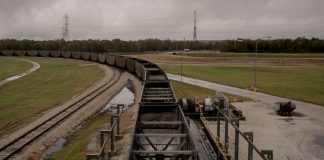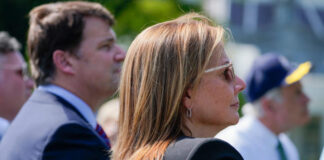NOVEMBER 18, 2018
 Mr. Trump in his New York office with Chrysler CEO Lee Iacocca in 1987. Photo: Robert R. McElroy/Getty Images
Mr. Trump in his New York office with Chrysler CEO Lee Iacocca in 1987. Photo: Robert R. McElroy/Getty Images
Three decades before President Trump’s trade agenda jolted the world, he laid out his vision in full-page newspaper advertisements foreshadowing what was to come.
“Japan and other nations have been taking advantage of the United States” for years, wrote the New York real-estate developer, in the typewritten letter addressed “To The American People,” his signature affixed to the bottom.
“‘Tax’ these wealthy nations, not America. End our huge deficits, reduce our taxes…” the September 1987 ads demanded. “Let’s not let our great country be laughed at anymore.”
Trade has been a defining issue for the Trump administration during its turbulent first two years, providing the basis for an economic and diplomatic approach that has shaken up the post-World War II global order. The administration has imposed tariffs on half the $500 billion in Chinese goods imported annually, and on steel and aluminum from around the world, while threatening to do the same on cars. Mr. Trump has strong-armed Japan, Europe, Canada and Mexico to the negotiating table.
Over several decades, the president has shifted many of his positions—including on health care, abortion and taxes—and even changed parties. On trade, however, he hasn’t wavered an inch, dating back to ideas first laid out in the late 1980s.
He has repeatedly returned to the same line of thinking, adjusted for different countries and changing circumstances. Back then, it was fear of Japan’s economic might that drew his attention. Today, it’s China, a topic that helped attract some of the administration’s top advisers to the then-candidate, and one that now unites Mr. Trump with lawmakers from across the political spectrum.
The president’s longtime acquaintances say he largely drafted his agenda based on beliefs forged in the cutthroat world of Manhattan real estate—that being ripped off is the ultimate failure and that transactions are a zero-sum game, producing a champion and a chump.
This isn’t only an explanation for the administration’s trade goals, but also an indicator of Mr. Trump’s broader governing philosophy and its reliance on his time as a businessman.
“Being a patsy in business, making a bad deal, was the worst thing in Donald Trump’s eyes that you could do,” says Roger Stone, an early political adviser who helped place the newspaper ads.
Asked in a recent Wall Street Journal interview about the origin of his views on trade, Mr. Trump said, “I just hate to see our country taken advantage of. I would see cars, you know, pour in from Japan by the millions.”
In the interview, Mr. Trump called Japan “interchangeable with China, interchangeable with other countries. But it’s all the same thing.”
Mr. Trump articulated the core principles that frame his trade agenda from his first national television interview—an October 1980 discussion with talk-show host Rona Barrett at the height of the Iran hostage crisis. Mr. Trump decried America as a country where “we just sit back and take everybody’s abuse.”
He touted business executives as smarter than politicians, arguing the most capable leaders don’t run for office: “They head major corporations.”
And he started mentioning the importance of negotiating skills to solve policy problems, such as the nuclear arms race with the Soviet Union. Trade soon became an obvious topic, with pundits talking about Japan surpassing the U.S. as the world’s leading economy—and even replacing the American economic model.
“I think part of the reason he was angry at Japan was that it started getting publicized as being so intelligent about business,” says Barbara Res, an executive at the Trump Organization from 1980 to 1992. “He might have resented that…I think most Americans, really, took offense at that.”
Shortly after the 1987 publication of Mr. Trump’s book, “The Art of the Deal,” he applied his world view in speeches and television interviews to a raging trade debate as Japan flooded the U.S. with inexpensive, high-quality autos and electronics. He continued gaining attention, and the book became a best seller.
His early antitrade jeremiads were “part of a strategy to float his name as a presidential candidate, get him an enormous amount of coverage, and show a different side of him,” says Mr. Stone, who also arranged a speech in which Mr. Trump bashed Japan to New Hampshire Republicans ahead of the 1988 presidential primary.
“I don’t think there was any chance he was going to run in 1988,” says Mr. Stone. “But he enjoyed being mentioned.” (Mr. Stone is currently under scrutiny by special counsel Robert Mueller relating to his time as an informal 2016 adviser to Mr. Trump, according to people familiar with the matter. Mr. Stone has denied wrongdoing.)
“Nobody knows foreigners better than I do,” Mr. Trump said in his New Hampshire speech. “I’d tell them: If you want the best defense you pay for it—just like I tell them that if you want the best apartment you pay for it.”
He followed his newspaper ads—they ran in the New York Times, Washington Post and Boston Globe—and a brief flirtation with the 1988 presidential campaign with appearances on talk shows, telling hosts such as Larry King and Oprah Winfrey: “I do get tired of seeing the country ripped off.” He told Diane Sawyer in 1989 he would impose a 15% to 20% tariff on Japanese imports, adding: “I’m not afraid of a trade war.”
He complained specifically about the persistent trade deficit with Japan costing the U.S. money, as well as Japanese “import quotas and tariffs to protect their own interest,” as he put it in his 1990 book “Trump: Surviving at the Top.”
Meanwhile, Japanese acquisitions of trophy properties in New York—notably Mitsubishi Estate Co.’s 1989 Rockefeller Center purchase—challenged Mr. Trump’s prominence on his home turf. It also made him dependent on their wealth.
Asked for a 1989 Time magazine cover profile about his net worth, he answered, using a racial slur: “Who the f knows? I mean, really, who knows how much the Japs will pay for Manhattan property these days?” He criticized U.S. trade negotiators for being duped by Japan while he boasted about selling overpriced condos to Japanese investors.
A likely influence on trade from that period was Lee Iacocca, the onetime Chrysler Corp. CEO who is 22 years Mr. Trump’s senior. Mr. Iacocca, who turned around the struggling car maker in the face of Japanese competition, became America’s first mega-celebrity executive of the postwar era.
The author of an eponymous best-selling book touting his business secrets, Mr. Iacocca’s fame came in part from his attacks on Japan, with declarations such as: “We’re the only country in the world that thinks we’re practicing free trade—and we’re getting killed.”
In 1986, Mr. Iacocca bought a co-op for his daughter at the new New York Trump Plaza, and joined Mr. Trump in a Florida real-estate venture. “They liked and admired each other and Trump was routinely invited to Chrysler events,” says Robert Lutz, Mr. Iacocca’s executive vice president.
Mr. Trump “often sounds like Lee,” Mr. Lutz said. “Many of his actions reflect what Iacocca would have done.” Mr. Iacocca, 94, declined to comment.
Mr. Trump made trade a signature issue during a brief run for the 2000 Reform Party presidential nomination. “If President Trump does the negotiating…watch our trade deficit dwindle,” he wrote in a 1999 Wall Street Journal op-ed headlined “America Needs a President Like Me.”
Despite Mr. Trump’s criticism of U.S. trade policies, he didn’t join the burgeoning anti-globalization movement of the 1990s, unlike other wealthy businessmen such as financier Sir James Goldsmith or textile magnate Roger Milliken, who funded studies and think tanks supporting the cause.
Antitrade advocates of the time were wary of affiliating with Mr. Trump, citing his gossip-page appearances and what they saw as his simplistic approach. “Being tagged with Trump could undermine your argument—you’d be tainted by his intellectually crude statements,” says Clyde Prestowitz, whose Economic Strategy Institute in Washington received funding from Mr. Iacocca’s company.
The trade debate changed at the turn of the 21st century in ways that fueled an ant-iestablishment movement more receptive to Mr. Trump’s message and style.
Business and political leaders backed an emerging consensus to foster and accelerate globalization, through pursuing free-trade pacts, expanding the World Trade Organization and encouraging China’s membership in the institution. That coincided with growing economic inequality, middle-class income stagnation, the 2008 financial crisis and disruption in U.S. manufacturing from Chinese imports.
Mr. Trump’s observations on China—based on his own experiences and stories from friends and business associates—gave his old views on trade a new urgency. He could find only Chinese glass and furniture for his buildings, despite looking for U.S.-made versions, he complained. The Trump Organization failed in at least four attempts at property deals in China. He struggled to secure trademarks in the country for the coveted Trump name.
Mr. Trump also turned serious about exploring a presidential run. Considering a 2012 GOP bid, Mr. Trump met for two hours in August 2010 with Steve Bannon, co-founder of the Breitbart News website that shared Mr. Trump’s views on trade and immigration.
Mr. Bannon was struck by the developer’s familiarity and focus on trade. “He didn’t know a lot of policy in a lot of areas,” recalls Mr. Bannon. On China, however, Mr. Trump expounded for 45 minutes: “He was woke.”
Mr. Trump started testing trade lines during Fox News appearances and political rallies. In April 2011, he revved up a Las Vegas crowd vowing that, as president, he would tell Beijing: “Listen, you motherf—ers, we’re going to tax you 25%!”
During a Sydney business trip a few months later, Mr. Trump urged his Australian audience to “screw” Beijing by raising commodity export prices. “They need you badly,” he said. “You have all the cards.”
Antitrade activists began to notice. Economist Peter Navarro, a prominent free-trade critic, began corresponding with Mr. Trump, sending him books and articles. Mr. Navarro got the developer to write a testimonial blurb for his 2012 documentary, “Death by China.”
Mr. Trump didn’t enter the 2012 primaries, but still tried to shape the trade debate. When giving his endorsement to eventual GOP nominee Mitt Romney, he cited the former Massachusetts governor’s hard-line China policy.
Mr. Romney in turn praised Mr. Trump, as “one of the few people who stood up and said, ‘You know what? China has been cheating.’”
By the time Mr. Trump finally launched his first serious presidential run in 2015, he had become the leading voice of the U.S. anti-globalization movement. He recruited Messrs. Bannon and Navarro to help translate his broad views into concrete proposals.
Pushback from some of his own aides, and from Republican legislators, slowed Mr. Trump’s agenda his first year in office, especially as they persuaded him trade changes could derail his signature tax cut. After the tax bill became law in December, he began carrying out the trade policies he had long envisioned.
Economist Stephen Moore of the conservative Heritage Foundation says he has tried to talk Mr. Trump out of his assertion that trade deficits harm the country, showing him historical data correlating high American trade deficits with low unemployment.
Mr. Trump would “usually fall back on his argument that he wants free trade but other countries aren’t playing by the rules,” Mr. Moore says.
“I respect economists,” Mr. Trump told the Journal. “But they’re usually wrong.”
In an Oct. 11 interview with CBS’s “60 Minutes,” Mr. Trump was asked if felt he had made any mistakes in his presidency. He named just one:
“I could have done trade a little bit earlier.”
Courtesy/Source: The Wall Street Journal










































































































